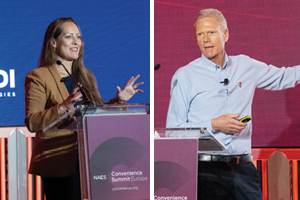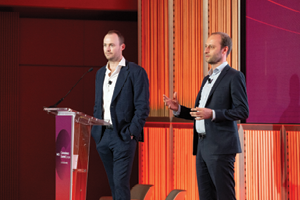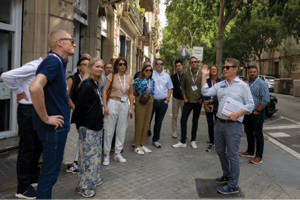Sagrada Familia is Barcelona’s signature building. Construction of the church began in 1882. It took 37 years to complete the first tower … leaving 17 more to build.
Chronic lack of funding, wars and Covid (not to mention anarchist attacks) have slowed or halted construction in the past. But in 2014, a new lead engineering firm joined the project and was given a mission to increase the speed of construction by a factor of 10. A suite of new technologies transformed the construction process, and the church is now scheduled to be completed in 2026.
NACS President and CEO Henry Armour likes to say that change comes slowly—and then suddenly. That’s the case with Sagrada Familia, a building that once seemed like it would permanently be under construction—until, suddenly, it was almost finished.
The idea that as an industry we’re in the “suddenly” phase across many segments was an undercurrent of the NACS Convenience Summit Europe, which took place in Barcelona over three days in June.
Here’s a look at just some of the many topics of conversation at the event.
The surge to finish Barcelona’s Sagrada Familia church echoes a retailing world where “slowly, then suddenly” resonates.
Are You Doing Loyalty Wrong?
In his presentation kicking off the event, Armour recounted his days as a c-store operator in the Pacific Northwest. His company, West Star, was one of the first to introduce a mag stripe loyalty card. Participants received points that they could then use for a discount on fuel or in-store merchandise.
“Two years into that program, I printed out the top 10 loyalty customers from every one of our 100 stores. I sat down with every manager, and I asked, ‘Do you know these people?’ Every manager said, ‘Absolutely.’ I went, ‘Wow, this is amazing. How do you know them?’”
The answer Armour received: “They were our best customers before we even started the program.” Armour took that information … and killed the program, which was only “giving margin back to people who valued my offer to begin with.”
Just having a loyalty program isn’t an accomplishment. And now with loyalty programs being common, Armour posited that operators should be asking themselves, “What does loyalty look like when everyone has a loyalty program?”
Juan Alfonso Herrero, an executive with Spanish grocer Mercadona, shared his company’s approach to loyalty during a deep dive on Mercadona’s overall strategy. Mercadona doesn’t have a loyalty program at all. Instead, with most of its sales coming from its five private-label brands and a focus on offering low prices and a smooth shopping experience, “I think we have been able to create loyalty without having a loyalty program, because customers are very loyal to our brands and to our model.”
Tom Fleming and Christophe Schmitt from consulting firm Oliver Wyman shared an example of loyalty done wrong: A fuel retailer partnered with a grocer on a loyalty program through which a customer could use points from buying fuel to earn a grocery discount and vice versa.
Problem No. 1 was site location: 85% of the grocery stores had a partner fuel site within five kilometers, but only 20% of the fuel sites had a partner grocery store within five kilometers. “So, at 80% of [the fuel sites], this was a proprietary program,” Fleming said.
Problem No. 2 was that the grocer was adding on additional benefits when the customer checked out to encourage people to spend their points at the grocer. That meant the fuel retailer “was paying for the points to be redeemed in the grocery store,” which was financially not sustainable the way the program was set up.
Problem No. 3 was a misalignment with the program and the fuel retailer’s primary target when it came to growth, which was light-duty truckers. Instead of appealing to truckers, the program had the most appeal to suburban women, and, in particular, suburban women who already were filling up at the retailer anyway.
In Barcelona, great food is readily available everywhere—even this yoga studio.
The larger takeaway: c-stores that were recently in the get-a-loyalty-program phase are now squarely in the refining and rethinking phase. The Oliver Wyman duo offered five tips:
- Review performance. Review the program against its own objectives as well as the overall company strategy.
- Focus on a target segment. Simplify and focus on one or two objectives with a certain audience segment.
- Use the data across the entire company.
- Invest in the customer experience.
- Evaluate how a loyalty program fits into your business in the future. Make sure you know why you have a loyalty program. Is it possible that your customer experience is already enough of a differentiator?
What does that fourth tip, investing in a customer experience, mean? Fleming sees a third generation of loyalty on the horizon. Generation one—the type of loyalty program Armour cancelled—was about discounts or rewards, plain and simple.
Generation two became experiential. Being a Starbucks member, for example, means that you can order ahead and skip the line. “Many people who use [the Starbucks] app do not use it for the stars that you get in the Starbucks reward program. They use it because it creates a better experience, and that is, I think, where loyalty is going for fuels and convenience retailers,” Fleming said.
The third generation will be about creating great experiences that feel unique and personal to the customer. Third-generation programs built around experience reduce the pressure to cut into margins, and may even mean the customer becomes less price-sensitive. If they associate your store with a great experience, the overall quality of your offer will be enhanced—your coffee tastes better to a customer who had a great experience, which was enabled by the loyalty program.
Changing Prices Digitally
For a visitor landing in Barcelona, it doesn’t take long to pick up on the fact that electronic shelf labels are widely adopted. The convenience store at the airport didn’t have electronic shelf labels … but it did have paper labels that were printed to look like they were digital. During the store tours portion of the event, attendees saw electronic shelf labels in action at retailers such as Bonpreu and Lidl.
“I think that this is the time where we finally have all the ingredients to make electronic shelf tags a practical and viable solution,” Linnea Geiss, COO at PDI Technologies, shared with event participants.
Reducing the burden on store employees, of course, is part of the rationale. “But the real unlock that’s going to make shelf tags a valuable asset for your business is all about decision optimization,” she said. Retailers have the ability to update prices in real time, change them by time of day or by region, use price changes as tool for testing and learning and even change a price as a call to action to download a loyalty app when a customer walks down an aisle.

‘The Platform Is Burning’
Jesper Østergaard shared the evolution of 7-Eleven stores in Denmark. Østergaard is the CEO of Reitan Convenience Denmark, the 7-Eleven franchisee in that country.
Today, the stores see about 900 customers per day and sell about 600 food and bakery products per day. 7-Eleven is growing in Denmark, with the Copenhagen airport alone home to 11 stores (one of which is a 7-Eleven-branded bookstore that happens to be the largest bookstore in Scandinavia.)
In other words, things are good.
Østergaard joined the company in 2011. “We were on a burning platform,” he said. The stores were dirty, uninviting and faced a stark milestone. A national law stipulating that supermarkets could not be open after 2 p.m. on Saturdays, on Sundays or on bank holidays was about to be repealed, cutting deeply into the stores’ customer traffic. In addition, popular categories like magazines and postcards were cratering. “We were losing a lot of money,” Østergaard shared.
“So we decided that we cannot predict the future … but probably we will still need to eat and drink in 50 years,” Østergaard recounted. “So we said, ‘We have to build our business around food and beverages.’”
In 2019, Reitan Convenience Denmark won the NACS International Convenience Retailer of the Year award for completely transforming its way of doing business.
For c-stores looking to evolve towards being foodservice providers, Østergaard shared the following insights:
- Have the right leaders in place. Operating a c-store where most products have a very long shelf life is very different than operating a restaurant/grocer/traditional c-store. Relatedly, build foodservice skills at the store and the corporate level.
- Don’t hide your new and improved foodservice. 7-Eleven Denmark didn’t have a huge marketing budget, so it used what it had to spread the message: The existing stores. It did so by moving the food to the front of store, so every customer had to walk past it.
- Add healthy choices. “We wanted to have all kinds of customers and to be able to serve all kinds of needs,” Østergaard said, which meant expanding beyond c-store staples.
- Think outside the store. Delivery is generating “quite a lot of orders per store,” Østergaard said, as well as large baskets. In addition, B2B catering is a growth category he is excited about.
- Embrace innovation and novelty. “From the very beginning, we were focused on introducing products that we, at least for some period of time, could say were ‘only at 7-Eleven.’”
On the last point of innovation, 7-Eleven Denmark has supported local entrepreneurs. One example Østergaard gave was of a company named, appropriately enough, Banana. It removes bananas from stores when they are past peak and turns them into banana bread, which is then sold at those same stores.

Separate Fuel and Food Brands
In the three days that c-store leaders gathered in Barcelona, it was often noted that in this city, great food is everywhere. It’s a culture of dining out, where the main meal takes place in the mid-afternoon and is frequently accompanied by wine and conversation.
At fueling sites, meanwhile, the stores tend to be small and in-store sales are traditionally dwarfed by forecourt sales.
So how do you convince customers to get food at your site—when they’re not used to doing so—while there are many other options nearby?
One answer is to create a separate foodservice brand.
Cepsa has embraced that idea with R’spiro, which curates a high-end, Starbucks-like vibe inside Cepsa stations. The layout and branding make it clear that consumers aren’t getting “gas station food”—they’re getting their food from a charming café that happens to be inside a convenience store that also happens to be behind a forecourt.
Jo Hayward, vice president, mobility and convenience retail at BP UK, shared that BP took a similar approach with its Wild Bean Cafe that it started 20 years ago. The sub-brand is now common throughout the UK at BP outlets. In addition, BP has extensive partnerships across the UK with Marks and Spencer, which is known for its larger department-store style outlets. Marks and Spencer also has small outlets at about 300 BP locations. Hayward said that the Marks and Spencer locations substantially outperform other UK locations.

The Confused Consumer
Bartosz Jesse, a partner at McKinsey & Company, shared some of the considerations consumers make when purchasing food. One key point: Consumers are confused.
In the UK, 46% of consumers agreed or somewhat agreed with the statement, “I find it hard to understand what I should do to be more healthy.” A full 53% of consumers in the UK agreed or somewhat agreed with the statement, “I find it hard to understand what I should do to be more sustainable.”
This means retailers need to do more than just offer healthier or more sustainable options. They need to take the next step, which is to educate the consumer about the in-store offer.

An AI-Powered Future
This article was written by AI. Well, not really. Instead, AI-powered software created a wonky, but still useful, transcript of all the presentations delivered at the event. (For example, “franchisee” becomes “French I see.”)
Still, any transcript is an improvement over no transcript, and the AI transcription is totally workable when paired with a recording. AI offers a change in terms of efficiency, but not a revolution. A human still needs to be at the keyboard.
AI was a huge topic of conversation at the event. At the same time, specific use cases for retail remain elusive.
The next NACS Convenience Summit Europe takes place in Copenhagen from 25-27, May 2025, and registration is open at convenience.org/CSE. By then, the conversation around AI should be much more concrete.